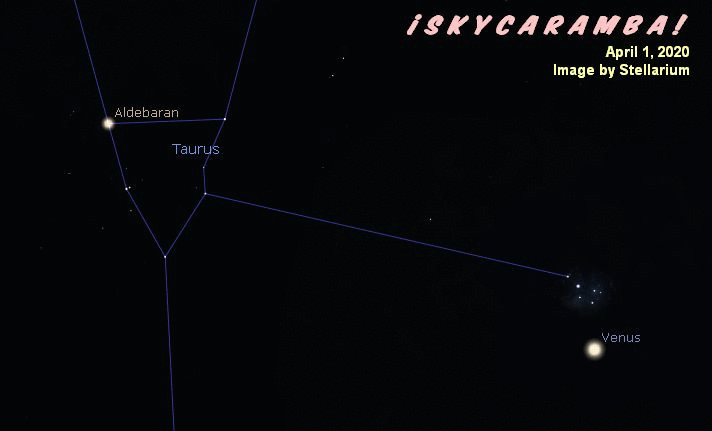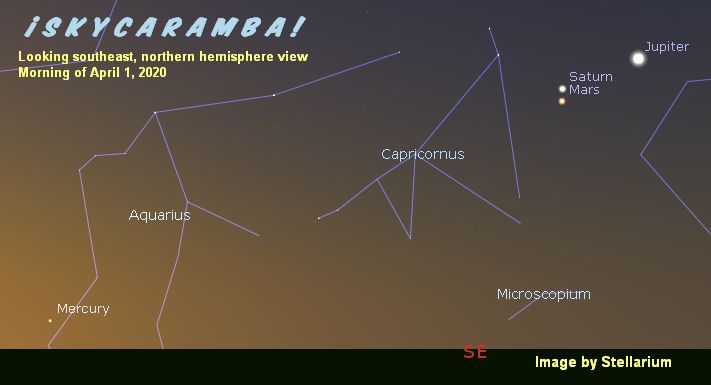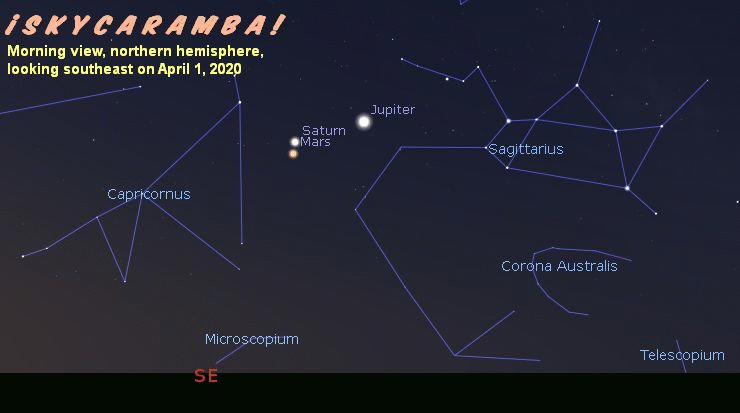
April begins with Venus just below the Pleiades in the evening sky. A first quarter moon is just above Wasat in Gemini near the meridian at sunset. Leo is rising with Boötes rising below it. Wait until after midnight and you’ll see Lyra and Cygnus rising. One of the best planetary get-togethers in a long time continues in the hours before sunrise with Jupiter, Saturn, and Mars just east of Sagittarius. Mercury is a morning object when April starts, but it’s rising soon soon before sunrise you may have trouble finding it.

Venus glides right by the Pleiades on the 3rd, looking like it’s the seventh sister home for a reunion, shining bright and getting the most attention. If you have looked upon this asterism in wonder of why the stars are called the seven sisters when you see only six, you’re not the first. Greek legends go back at least a couple thousand years as to why one sister or another is hiding or absent. She may be Elektra, in hiding while Troy burns. She may be Merope, who married a mortal and no longer deserves the same glory as the rest. Or she may be Celæno, blasted out of the sky by a thunderbolt.
An Onondaga legend also relates this star cluster as having a missing member. The story tells of a party of Indians whose children danced every day by a lake. During a lull in the hunting time, they had little food and should have been conserving their energy. But they didn’t, even after an old, wise man appeared to warn them. And then, during one of their dances, the children began rising into the sky. The one who looked back became a falling star. The rest became the asterism the Onondaga call Oot-kwa-tah.
By the 26th, Venus has moved well on toward Auriga. A waxing crescent moon is nearby.

In the morning sky, Mars has moved over the course of a few weeks from the west side of Sagittarius to the east side where Jupiter and Saturn are also stationed now. The red planet is close to the ringed planet on the morning of the 1st. Jupiter is just a little west of them. Jupiter and Saturn aren’t moving much. They are still between Sagittarius and Capricornus on the 14th, 15th, and 16th, when a waning moon is in the neighborhood and Mars is deep into the constellation of the goat.

Uranus is an evening object for most of this month, but not by much. The planet is moving eastward. The sun is moving eastward faster. Uranus is in conjunction on the 26th.
The moon is at first quarter on the 1st. It’s also at lunistice the same day, 23.7° north of the equator. People at or close to the Tropic of Cancer will see the moon overhead right about the time the sun sets. The moon is at perigee 356,900 km from the earth when it crosses the equator southward on the 7th and is full on the 8th. Southern lunistice is on the 13th. Last quarter is on the 14th. Apogee occurs on the 20th at 406,500 km. The moon goes north of the equator again on the 23rd and reaches northern lunistice again on the 28th. This month has a second first quarter on the 30th.
The moon’s notable conjunctions this month are with Pollux on the 2nd, Jupiter on the 14th, Saturn on the 15th, Mars on the 16th, Neptune on the 19th, Mercury on the 21st, Uranus on the 23rd, Aldebaran on the 26th, and Pollux again on the 29th.
Neptune and Mercury will be 1.3° apart on the 4th. Pluto and Jupiter are 0.7° apart on the 5th.
The Lyrids meteor shower possible peak time is at 6 hours UT on the 22nd. With an almost new moon, there’ll be little moon light to interfere. The parent comet is C/1861 G1 Thatcher. With observations noted from as long ago as 687 BC, this shower is believed to be the oldest one observed that still exists. This is a mainly northern hemisphere shower. The radiant point, near Lyra, rises in mid-evening local time, so most of the night can be a good time to observe. The best time is as dawn approaches but before the morning light interferes.
